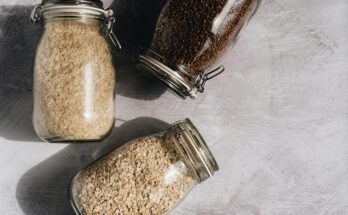Cooking with Seaweed Is a Flavor-Infusing, Nourishing Ingredient for Kitchen Seaweed was a diet staple of many coastal cultures, especially in Asia. However, only recently has it gained global esteem for its purported health benefits and distinct flavor. Seaweed is chock-full of the essential vitamins, minerals, and antioxidants. Thus, it presents itself as an interesting nourishing product in your diet and a versatile ingredient in the kitchen. Soup, salad, or snack are just some of the countless avenues in which seaweed may find its way into our feed.
Why Refer to Seaweed in Your Cooking?
Cooking with Seaweed Let us first consider few reasons as to why seaweed ought to form part of our culinary expedition. Here goes a countdown of a few reasons why you should consider it in your meals.
- A source of micronutrients: Seaweed is among the richest sources of iodine, which is associated with helping in the normal function of the thyroid gland. Seaweed also provides calcium, magnesium, iron, and a variety of vitamins, including vitamins A, C, and K.
- Invaluable Antioxidants: Flavonoids and carotenoids are several powerful antioxidants found in seaweed. These antioxidants are utilized to manage oxidative stress and to counteract body inflammation.
- Low Caloric Intake: Seaweed is naturally low in calories and high in fiber foods, making them effective in controlling weight loss while inducing feelings of satisfaction.
- Sustainable food: Seaweed is quick and easy to grow, while requiring little to no resources, such as fresh water and fertilizers.

A Few Types of Seaweed-to-Try
Cooking with Seaweed There are so many seaweeds, and they don’t just differ in flavor and texture. Here are some of the more popular seaweeds used in cooking:
- Nori-This thin and delicate seaweed is the one generally used for sushi rolls and can also be crumbled over boiled rice, salads, or soups for an added burst of flavor.
- Kombu-This thick, dark green seaweed is usually used in Japanese cooking, especially in making dashi, the stock for soups, broths, and sauces, lending an extra boost of umami to soups, stews, and sauces.
- Wakame-Mildly flavored, wakame is commonly found in miso soup, salads, or stir-fries. It is very soft when rehydrated, hence working well with countless dishes.
- Dulse-A chewy, slightly smoky, salty red seaweed, dulse is eaten raw but most frequently put into soups, sprinkled on roasts, or just used on roasted vegetables.
- Arame-A mild-flavored seaweed generally used in salads, stir-fries, and grain bowls. Its fine strands make it an easy addition to a variety of dishes.

Seaweed Cooking – Delicious Recipes to Try
1. Miso Soup with Wakame
Cooking with Seaweed A classic Japanese dish, miso soup takes on seaweed’s delicate briny flavor. Here’s an exceptionally simple recipe.
Ingredients:
- 2 tablespoons miso paste-White or red
- 4 cups water or vegetable broth
- 1/4 cup dried wakame seaweed
- 1/2 cup tofu, diced
- 2 green onions, sliced
Instructions:
- In a pot, heat the water or broth over medium heat.
- Add the miso paste and stir until dissolved.
- Add the wakame seaweed and allow it to rehydrate for a minute or two.
- Add in the cubes of tofu; simmer that for another 5 minutes, or until the tofu has warmed throughout.
- Garnish the soup with sliced green onions before serving.
This iron-packed soup will warm you up, one bite at a time.

2. Seaweed Salad with Sesame Dressing
Cooking with Seaweed This salad is slightly sour and crisp and that gives it an edge over others. This is mostly a starter in many Japanese restaurants, light but with a taste that is sure to bring everyone back to more.
Ingredients:
- 1 cup dried wakame or hijiki seaweed
- 1 tablespoon sesame oil
- 1 tablespoon rice vinegar
- 1 teaspoon soy sauce
- 1 teaspoon honey or maple syrup
- 1 tablespoon sesame seeds (toasted)
- 1 cucumber, thinly sliced
- 1 carrot, julienned
- A handful of fresh cilantros (optional)
Procedure:
- Soak the seaweed in water for 10-15 minutes to soften. Drain and set aside.
- In a small bowl, combine the sesame oil, rice vinegar, soy sauce, and honey or maple syrup. Whisk well.
- In a large bowl, mix the rehydrated seaweed with the cucumber and carrot.
- Pour the dressing over them and seaweed mixtures together and toss gently to coat.
- Sprinkle the salad with toasted sesame seeds and garnish with fresh cilantro if desired.
This refreshing salad makes a perfect side salad or light lunch, one balanced in taste and textures.

3. Seaweed Crisps
Are you looking for a healthy snack? These seaweed crisps are easy to make and highly addictive. They are crispy, salty, and full of flavor.
Ingredients:
- 10 sheets of nori
- 1 tablespoon olive oil or sesame oil
- Sea salt, to taste
- Optional: a sprinkle of chili flakes or garlic powder
Instructions:
- Preheat oven 350°F/175°C.
- Brush nori sheets on both sides with olive or sesame oil.
- Cut nori sheets into bite-sized pieces.
- Arrange in single layer on a cookie sheet.
- Bake in preheated oven for 5-7 minutes until crispy and slightly browned. Watch them closely to avoid burning.
- Sprinkle with sea salt, and if you want some heat, sprinkle with chili flakes or garlic powder.
- Enjoy as a snack or as a topping for soups or salads.
These seaweed crisps are crunchy, salty, and packed with nutrients, making them a perfect alternative to chips.

How to Use Seaweed in Cooking
Cooking with Seaweed
- Soak Dried Seaweed: With the exception of some more unusual or specialty varieties, most will need soaking in water in order to revive. The times for soaking will depend on the kind of seaweed being used, so be sure to follow the instructions on the package.
- Moderation: Seaweed has quite a strong flavor; therefore, a very little goes a long way. Add at first small amounts and adjust for taste.
- Try Different Varieties: Each seaweed will bring with it distinct flavors and textures in dishes. Don’t be afraid to mix and match to find your best favorites!

Final Thoughts
Cooking with Seaweed is a great way to introduce new flavors, textures, and nutrients to your meals. Whether you are preparing a traditional dish such as miso soup or creating your own unique recipes, seaweed is sure to add an extra flair to your dishes. So why don’t you investigate the sea’s offerings and embrace including seaweed into your regular cooking? Your palate- (and health) will thank you!
Enjoy cooking!



